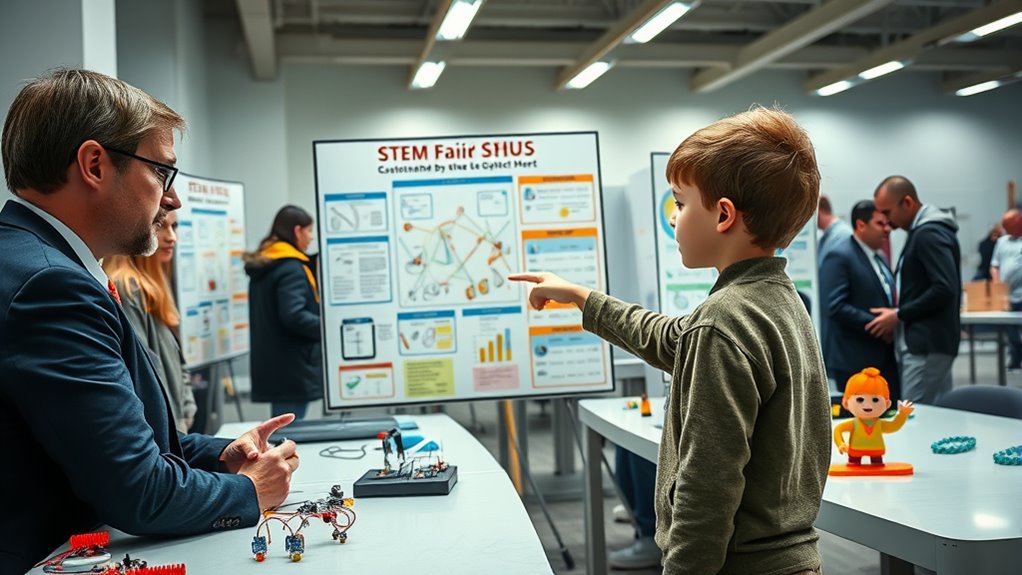To guide your child without doing the project, focus on asking open-ended questions that promote critical thinking and problem-solving. Encourage them to research and troubleshoot challenges independently, offering resources and support rather than direct answers. Break the project into manageable steps with clear deadlines, and help them stay organized. Remember to celebrate their efforts and boost confidence along the way. If you want to learn more, you’ll find helpful tips to make the process both enjoyable and educational.
Key Takeaways
- Use guiding questions to stimulate your child’s critical thinking and problem-solving skills.
- Offer resources and advice instead of completing tasks, fostering independence.
- Encourage thorough planning and organization to build confidence and reduce stress.
- Teach safety protocols and responsible handling to ensure a secure project environment.
- Practice clear, enthusiastic explanations to help your child effectively communicate their project.

Participating in a STEM fair can be exciting, but it also requires careful planning and organization. As a parent or mentor, your role is to guide your child through the process without doing the project for them. One of the most important aspects is guaranteeing they understand science safety. Before they start gathering materials or conducting experiments, sit down together to review safety protocols. Teach them to handle chemicals, electrical components, and lab tools responsibly. Make sure they know to wear protective gear like goggles and gloves, and emphasize the importance of working in a well-ventilated area or under supervision if necessary. Reinforce that safety isn’t just a rule—it’s vital for preventing accidents and ensuring a smooth project experience.
Once safety is addressed, focus on helping your child prepare their project presentation. This is where they communicate their understanding and findings clearly and confidently. Encourage them to create a visual display that’s neat, organized, and visually appealing. Their presentation should include key components such as the hypothesis, procedures, results, and conclusions. Guide them to practice explaining their project aloud, emphasizing clarity and enthusiasm. Avoid doing the talking for them; instead, ask guiding questions like, “What’s the main point you want to share?” or “How did your results support your hypothesis?” This boosts their confidence and ensures they can engage with judges and visitors effectively.
Additionally, understanding the role of contrast ratio in project displays can help them evaluate how well their visuals will stand out in different lighting conditions. Helping your child stay organized is also essential. Break down the project into manageable steps with a timeline, so they don’t feel overwhelmed. Keep track of deadlines for materials, experiment phases, and presentation preparation. Encourage them to document their work thoroughly—photos, notes, and data—so they have everything ready for the big day. This organization makes the final presentation smoother and less stressful.
Frequently Asked Questions
How Can I Motivate My Child to Choose a Project?
You can motivate your child to choose a project by encouraging creative brainstorming and interest exploration. Ask open-ended questions about what excites them, and suggest they explore topics they’re curious about. Offer support and praise their ideas to boost confidence. Help them see the fun in discovering new things, and remind them that their passion will make their project stand out. Your enthusiasm can inspire their motivation and spark their curiosity.
What if My Child Struggles With the Scientific Method?
If your child struggles with the scientific method, gently guide them through experimental design and hypothesis formulation. Encourage them to ask questions and think about what they want to test. Break down each step into simple tasks, like identifying variables or making predictions. Offer support without taking over, helping them build confidence in their problem-solving skills. This approach helps them understand the process and enjoy discovering answers on their own.
How Do I Ensure My Child’s Project Is Original?
Picture a blank canvas and a vibrant palette—your child’s project is their masterpiece. To guarantee originality, focus on plagiarism prevention by emphasizing honest research and proper citations. Encourage creativity enhancement through brainstorming unique ideas and exploring new angles. By fostering their imagination and guiding them to develop their own approach, you help them create an authentic project that stands out, showcasing their true understanding and innovation.
What Are Common Mistakes to Avoid During Project Guidance?
When guiding your child through project brainstorming and resource gathering, avoid common mistakes like giving too much direction or taking over the work. Instead, encourage their independence, ask open-ended questions, and help them find resources themselves. Don’t rush their process; give them time to explore ideas. Keep your focus on supporting their learning, not doing the project for them. This approach builds confidence and fosters creativity.
How Can I Help My Child Manage Time Effectively?
Time management is the key to a stress-free project. You can help your child by encouraging them to develop planning strategies, like breaking tasks into smaller steps and setting deadlines. Remind them to prioritize tasks and avoid last-minute rushes. Keep a schedule or checklist to stay on track. Remember, a stitch in time saves nine, so starting early and staying organized will make the process much smoother.
Conclusion
Remember, guiding your child through their STEM fair project can boost their confidence and curiosity. Did you know that students who receive parental support are 30% more likely to participate and enjoy STEM activities? By offering encouragement and strategic guidance instead of doing the project for them, you help your child develop problem-solving skills and independence. Embrace the process together, and watch them grow into confident young scientists ready to explore the world!










